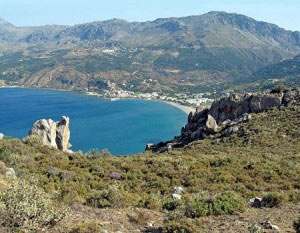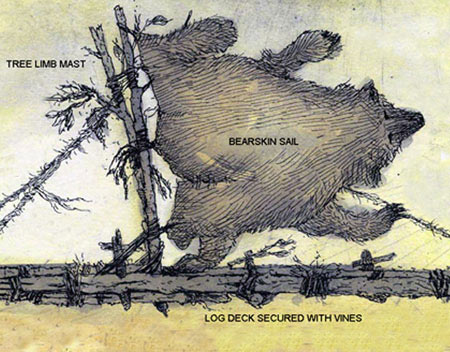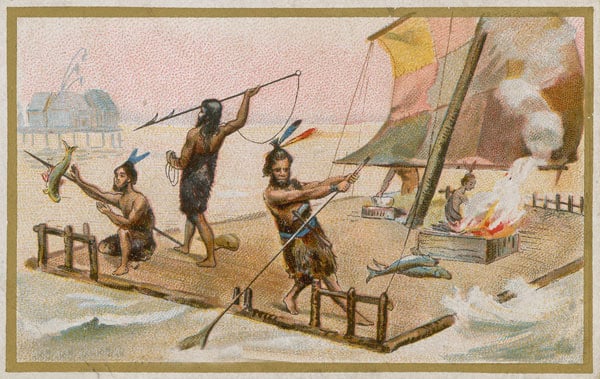The Discovery that Revealed Ancient Humans Navigated the Seas 130,000 Years Ago
It was a few years ago that a Greek-American archaeological team made a startling discovery – they found the oldest indications of seafaring and navigation in the world, in an area called Plakia on Crete Island in Greece. It is an incredibly important discovery that is given little attention, despite the fact that it reached the top ten discoveries of 2010. Their research is forcing scholars to rethink the maritime capabilities of early human and pre-human cultures.
The team of archaeologists were carrying out excavations in a gorge on the island of Crete when they discovered a Palaeolithic site in the canyon of Preveli, where more than 30 hand axes and hundreds of other stone tools, such as cleavers and scrapers, made from quartz were found scattered across more than 20 different locations. Until this discovery, it was believed that ancient humans reached Crete, Cyprus, a few other Greek islands, and possibly Sardinia, no earlier than 12,000 years ago. However, remarkably, the stone tools found at Parkia were dated to at least 130,000 years old.

Stone tools found on Crete are evidence of early sea voyages. Credit: Nicholas Thompson and Chad DiGregorio / NYTimes.
The tools were dated through stratigraphic analysis, a branch of geology which studies rock layers. The cliffs and caves above the shore were uplifted in the ancient past by tectonic forces. The exposed uplifted layers represent the sequence of geologic periods that have been well studied and dated. The team analyzed the layer bearing the tools and determined that the soil had been on the surface 130,000 to 190,000 years ago.

Rocky bluffs around the village of Plakia were actually the shoreline zone in prehistoric times. This is where the team began excavations. Image source.
Considering Crete has been an island for five million years, the tools could have only arrived in that location if ancient humans or pre-human species travelled there by boat. This means that sea travelling existed in the Mediterranean Sea tens of thousands of years before what archaeologists initially believed, and that early Homo sapiens or their ancestors used boats capable of open-sea navigation. Prior to this discovery, the oldest established marine travel was the sea-crossing migration of anatomically modern Homo sapiens to Australia, where they had to cross between islands with the maximum open water distance of 71 km, beginning about 60,000 years ago, although this time line is debatable.
What is particularly interesting, is that the style of the tools closely resembles artifacts from the stone technology known as Acheulean, which originated with pre-human populations in Africa. For decades, the standard hypothesis has been that Acheulean toolmakers reached Europe and Asia via the Middle East, passing mainly through what is now Turkey into the Balkans. The findings in Crete raise the possibility that human migration was not confined to land routes and may have included expansion from Africa across the Strait of Gibraltar to Spain, or from Libya to Crete – a stretch of approximately 200 miles (320 km).
It was initially believed that the earliest boats were log rafts with sails made of animal skins sewn together and lashed to a tree limb to catch the wind. However, experts on early nautical history have said that the ancient mariners would have required something much studier to make the distance between North Africa and Crete.

One theory is that the boats of Stone Age migrants were log rafts with sails made of animal skins sewn together and lashed to a tree limb to catch the wind. Image source.
Archaeologists cannot be certain about whether the tools found on Crete were made by Homo sapiens or another pre-human ancestor. One hundred and thirty thousand years ago, modern humans shared the world with other hominids, like Neanderthals and Homo heidelbergensis. It has long been believed that early humans, and certainly pre-human species, were incapable of creating boats or navigating across open water. But this discovery challenges that assertion and suggests that they were capable of much more sophisticated behaviour than their relatively simple stone tools would suggest.
“The results of the survey not only provide evidence of sea voyages in the Mediterranean tens of thousands of years earlier than we were aware of so far, but also change our understanding of early hominids’ cognitive abilities,” said the Greek Culture Ministry in a statement about the discovery.
The research, if confirmed by further study, will turn the timetable of technological development on its head and offer new perspectives on how ancient humans migrated and expanded throughout the world.
Featured image: Raft in the Stone Age. Credit: Look and Learn / Barbara Loe Collection
By John Black
Related Links
Primitive Humans Conquered Sea, Surprising Finds Suggest
Palaeolithic Stone Tools from Plakias, Crete, Named a Top Ten Discovery by Archaeology Magazine


















Comments
Stratigraphic analysis is still largely based on uniformitarian thinking, a geological premise that has been largely falsified by extensive evidence of repeated catastrophic episodes throughout the history of the planet. Catastrophic forces can accomplish in minutes what it would take a uniformitarian environment tens of thousands of years to achieve, if it could achieve it at all. (Ice rafted boulders are an excellent example of a geological phenomena that simply cannot be replicated using “one grain of sand, one drop of water at a time")
IMO this means stratigraphy dates should be taken with a large grain of salt and a huge margin of error, trending toward the present.
It is not hard to explain. You are forgetting that there was a Wurm glacial which set a southern limit of ice near the Island of Crete. They could travel on bare foot from Asia to Crete.
I am amazed, but not surprised. We must keep in mind, this is the oldest evidence we have found, so far!
And if they could sail the waters 200K yrs ago then that means they could have gone anywhere.
That's interesting enough that the tools were made out of quartz.
Peace and Love,
Ricky.
Pages